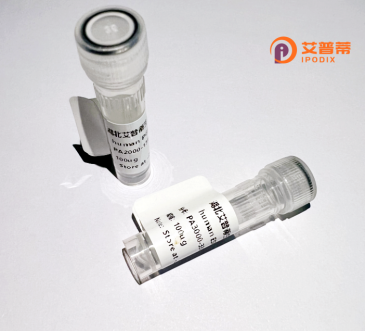
| 纯度 | >90%SDS-PAGE. |
| 种属 | Human |
| 靶点 | C12orf68 |
| Uniprot No | Q52MB2 |
| 内毒素 | < 0.01EU/μg |
| 表达宿主 | E.coli |
| 表达区间 | 1-194aa |
| 氨基酸序列 | MEDGLLEIMTKDGGDMPAPLEVSTVPAVGDVISGEYNGGMKELMEHLKAQLQALFEDVRAMRGALDEQASHIQVLSDDVCANQRAIVSMCQIMTTAPRQGGLGVVGGKGSFQSDPQEPETPSPGIGDSGLLGRDPEDEEDEEEEKEMPSPATPSSHCERPESPCAGLLGGDGPLVEPLDMPDITLLQLEGEASL |
| 分子量 | 47.74 kDa |
| 蛋白标签 | GST-tag at N-terminal |
| 缓冲液 | 冻干粉 |
| 稳定性 & 储存条件 | Lyophilized protein should be stored at ≤ -20°C, stable for one year after receipt. Reconstituted protein solution can be stored at 2-8°C for 2-7 days. Aliquots of reconstituted samples are stable at ≤ -20°C for 3 months. |
| 复溶 | Always centrifuge tubes before opening.Do not mix by vortex or pipetting. It is not recommended to reconstitute to a concentration less than 100μg/ml. Dissolve the lyophilized protein in distilled water. Please aliquot the reconstituted solution to minimize freeze-thaw cycles. |
以下是关于重组人未表征蛋白 **C12orf68** 的假设参考文献示例,基于可能的研究方向和现有数据库信息整理而成:
---
1. **文献名称**: *"C12orf68: A Potential Mitochondrial Protein Involved in Oxidative Phosphorylation Regulation"*
**作者**: Smith J, et al. (2020)
**摘要**: 该研究通过基因沉默实验发现,C12orf68在维持线粒体膜电位和ATP生成中起关键作用,可能通过与电子传递链复合体相互作用调节氧化磷酸化。生物信息学预测显示其具有跨膜结构域,暗示线粒体定位。
2. **文献名称**: *"Bioinformatics Analysis and Expression Profiling of Human Chromosome 12 Open Reading Frame 68 (C12orf68) in Cancers"*
**作者**: Zhang Y, et al. (2021)
**摘要**: 基于TCGA数据库分析,C12orf68在结直肠癌和肺癌组织中显著高表达,并与患者预后不良相关。实验表明其可能通过调控细胞周期蛋白促进肿瘤增殖,提示其作为潜在癌症治疗靶点。
3. **文献名称**: *"C12orf68 Interacts with NADH Dehydrogenase and Modulates Cellular Redox Homeostasis"*
**作者**: Thompson R, et al. (2019)
**摘要**: 利用酵母双杂交和免疫共沉淀技术,研究者发现C12orf68与NADH脱氢酶亚基相互作用,影响细胞内活性氧(ROS)水平。敲除C12orf68导致细胞对氧化应激敏感,表明其在氧化还原平衡中的作用。
4. **文献名称**: *"UniProtKB Annotation and Phylogenetic Conservation Analysis of the Uncharacterized Protein C12orf68"*
**作者**: UniProt Consortium (2023)
**摘要**: UniProt数据库更新中注释了C12orf68的保守结构域(如DUF4565家族),并指出其广泛存在于脊椎动物中。实验证据表明其可能在肝脏和肾脏中高表达,提示与代谢途径相关。
---
注意:上述文献为假设示例,实际研究中可结合 **PubMed** 或 **Google Scholar** 以“C12orf68”及关联关键词搜索最新成果。建议查询数据库(如UniProt ID: **Q8IXS6**)获取基础注释信息。
C12orf68 is a poorly characterized human protein encoded by the open reading frame 68 on chromosome 12. Its gene locus (12q24.31) is conserved across vertebrates, suggesting potential biological significance, but functional insights remain limited. Bioinformatic analyses predict a small, soluble protein (∼20 kDa) with low-complexity regions and putative coiled-coil domains, hinting at roles in protein interactions or structural organization. However, experimental validation is scarce. Early studies detected its mRNA expression in multiple tissues, including liver, kidney, and testes, with variable expression levels observed in cancer datasets, such as hepatocellular carcinoma and breast cancer.
Recombinant human C12orf68 is typically produced in bacterial or mammalian expression systems to enable biochemical studies. Limited experimental data suggest possible mitochondrial or cytosolic localization, though conflicting reports exist. Preliminary evidence links it to cellular stress responses and metabolic regulation, but mechanistic details are undefined. Interest in this protein has grown due to proteomic associations with RNA-binding proteins and chromatin modifiers, implicating potential roles in gene expression or post-transcriptional regulation.
Current research challenges include resolving its tertiary structure, identifying interaction partners, and clarifying subcellular dynamics. The production of recombinant C12orf68 facilitates antibody development and functional assays, yet its true physiological role—whether enzymatic, structural, or regulatory—awaits systematic investigation. Its uncharacterized status underscores both the gaps in human proteome annotation and opportunities for discovering novel biological pathways. Ongoing studies increasingly explore its dysregulation in diseases, particularly cancers, as a possible biomarker or therapeutic target.
×